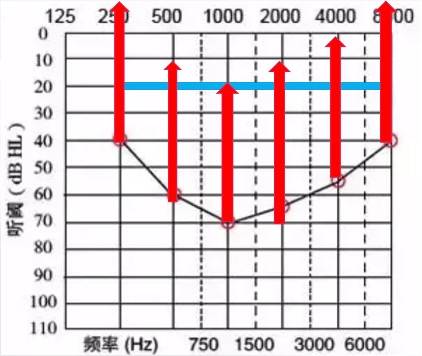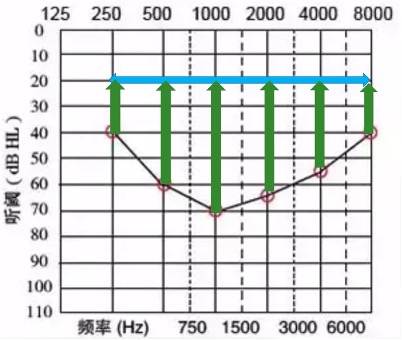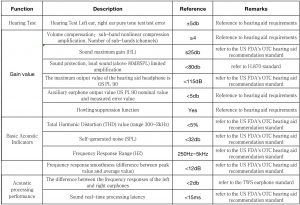1. Basic requirements for Hearing Enhance headphones
(1) The premise of the hearing aid function: safety
The technical principle of the realization of the hearing aid is the gain amplification of the sound. Safety refers to sound amplification without damaging existing hearing.
Sound is distributed in different hearing frequency points (Hz). From the perspective of human hearing principles, human hearing loss often manifests as different degrees of loss (dB) at different frequency points (Hz).
The concave curve is a moderate hearing loss curve. If the amplification of each frequency point is linearly amplified according to the hearing loss of 1000HZ, the sound volume of other frequency points will be too large, resulting in further hearing loss of other frequency points. More importantly, from the perspective of audiology, sensorineural hearing loss is irreversible. Headphones or sound amplifiers on the market now amplify the volume at the same amplitude as shown below.

Medical-grade hearing aids need to be amplified at different volumes according to the hearing loss at different frequencies, which is called segmental gain amplification of sound.

Therefore, from the perspective of hearing protection, using the segmented gain algorithm to perform sound gain (soundloudness compensation) is the most basic requirement for hearing enhance headphones. In order to do segmental gain processing, the user has to perform certain audiometry.
During the sound gain process, the sound is amplified. Therefore, if the noise is not eliminated cleanly, the sound after gain will be very noisy. This kind of noise reduction is dialogue noise reduction, which is the opposite of the call noise reduction principle in general headphones.
In addition, due to the structure of the hearing aid or earphone, the mic and the speaker are integrated. Therefore, the playback after the sound gain will re-enter the mic, resulting in a cyclic coupling of the sound, that is, howling (generally, the playback of TWS headphones is on the other end of the remote end of the call), so howling suppression must also be equipped.
To sum up, there are four basic algorithms related to hearing safety: accurate fitting (including audiometry), segment gain, dialogue noise reduction, and howling suppression.
(2) The main function of auxiliary listening: to hear clearly
In the hearing aid industry, the effect of hearing can be divided into two levels: audible and hear clearly. The difference between these two levels is that the volume of some sounds is so loud that they can be heard, but they cannot be heard clearly, which is the problem of speech resolution.
There are several aspects to improving speech resolution, including dialogue noise reduction, multi-scene, and rehabilitation. Noise reduction and scenes are discussed here.
Dialogue noise reduction
Conversation noise reduction refers to the noise reduction performed by people and people in the scene of a live face-to-face dialogue.
In this dialogue scene, the voice of the person on the opposite side is mixed with ambient noise. It is necessary to extract the human voice in the mixed sound and remove the noise. This will make the sound amplify while the noise is not amplified. Otherwise it will be too noisy (this is one of the important indicators of hearing aid quality).
multiple scenes
When using hearing aids, sound compensation is not only in the dialogue scene, but also when making a phone call (SCO mode, Synchronous Connection Oriented) and using a mobile phone to play audio and video (A2DP, Advanced Audio Distribution Profile). Similarly, when the auxiliary listening headphones are in use, the gain of the sound should also support these scenarios. Other techniques include speech sound enhancement, bandwidth expansion, and whisper enhancement.
To sum up, the algorithms related to intelligibility include segment gain and dialogue noise reduction, and also support the use of scenarios corresponding to the two protocols, SCO and A2DP. Of course, accurate audiometric algorithms are the foundation.
2. Function and performance requirements of auxiliary listening headphones
Auxiliary earphones need to have the following functions to meet the needs of people with mild hearing loss.
(1) Audiometry function: understand the hearing situation and personalize the hearing compensation
Accurate hearing test to generate hearing report
According to the hearing report, automatically adjust the hearing aid compensation parameters
(2) Hearing aid function: make people with mild hearing loss hear more clearly
Sound gain≤25dB
Segment compression compensation: hear clearly without hurting your ears;
Howling suppression: prevent howling caused by gain;
Dialogue noise reduction: ambient vocal extraction, ambient noise cancellation
SCO, Auxiliary Amplification in A2DP Mode;
(3) Performance requirements for auxiliary listening headphones
The performance of auxiliary listening headphones is reflected in several aspects:
sound processing performance; The performance of the whole machine;
The performance of sound processing is mainly reflected in the delay (latency) of the sound. The delay cannot be higher than 15ms. Above this value, the sound will have an echo effect, preventing normal conversation. The performance of sound processing is directly related to the algorithm model. In the third article of this series of articles, “Introduction to Auxiliary Headphone Solution Providers”, the difficult part of the algorithm will be introduced more. The performance of the whole machine includes the battery life of the headset.
described as follows:
(1) It has the pure tone audiometry function of hearing aids, and the error is less than ±5dB.
(2) Similar to hearing aids, it supports simple hearing fitting, and performs nonlinear compression and amplification in sub-bands.
(3) Monitor sound over 80dBSPL (according to ITU-TH.870 standard). Loud suppression of >80dB sound to protect hearing.
(4) OSPL90: This is the output standard for reference hearing aids. It refers to the maximum energy that a hearing aid can produce without distortion, similar to how we need to consider the horsepower of a car when buying a car. How many decibels the output power can reach without distortion, often used to describe the maximum output. In the past, we generally called it SSPL90, and now we call it OSPL90, which means 90dB to the sound, to see under what circumstances the hearing aid is saturated. Now this is a widely used standard, and the maximum output is generally around 115dB to 145dB. . Auxiliary listening OSPL90=95~120 (ordinary headphones: ~105), the difference between the nominal value and the measured value is <5dB. (5) Real-time sound processing, delay <15ms, avoid echo effect. Shenzhen WinTo Co. Limited have been committed to develop headphones with Hearing Enhance since 2019. Welcome to contact with us. [/av_textblock]

